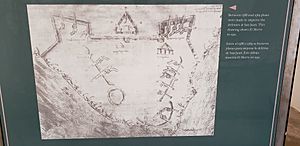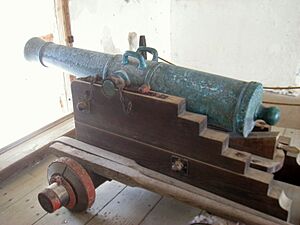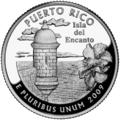Castillo San Felipe del Morro facts for kids
Quick facts for kids Castillo San Felipe del Morro in San Juan, Puerto Rico |
|
|---|---|
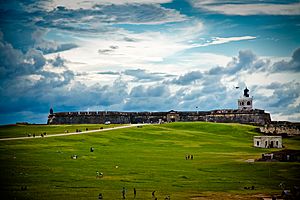
Castillo San Felipe del Morro
|
|
| Location | San Juan, Puerto Rico |
| Built | 16th century |
| Governing body | National Park Service |
| Type | Cultural |
| Criteria | vi |
| Designated | 1983 (7th session) |
| Part of | La Fortaleza and San Juan National Historic Site in Puerto Rico |
| Reference no. | 266 |
| Region | North America and West Indies |
| Designated | October 15, 1966 |
| Part of | San Juan National Historic Site |
| Reference no. | 66000930 |
| Lua error in Module:Location_map at line 420: attempt to index field 'wikibase' (a nil value). | |
Castillo San Felipe del Morro, often called El Morro, is a huge old fort in San Juan, Puerto Rico. It was built hundreds of years ago, between the 1500s and 1700s, to protect the city.
Contents
Why Was El Morro Built?
El Morro sits on the very northwestern tip of Old San Juan. It was named after King Philip II of Spain. The fort's main job was to guard the entrance to the San Juan Bay. It kept the Spanish city of San Juan safe from enemies coming by sea.
In 1983, El Morro was named a World Heritage Site by the United Nations. This means it's a very important place for everyone to protect. More than two million people visit El Morro every year. It's one of Puerto Rico's most popular places to see! Across the bay, a smaller fort called El Cañuelo helped El Morro protect the bay entrance.
How Was the Fort Built?
Building El Morro and its walls started in 1539. This was ordered by King Charles V of Spain. The first part of the fort was built by Diego Ramos de Orozco. Its main goal was to control the harbor entrance and defend San Juan.
To protect the city while the fort was still being built, a small, early fort was put up. This first part is about 10% of the whole huge structure you see today.
Designing the Fort's Defenses
In 1587, military experts Juan de Tejeda and Juan Bautista Antonelli drew the final plans for El Morro. Their design followed the strong Spanish rules for building forts. Construction began in March 1589. Skilled workers like stonecutters and masons helped, along with 150 enslaved people.
The new defenses included a large wall system called a "hornwork." This protected the land side of the fort. Two half-bastions, named "Tejeda" and "Austria," were built. They were connected by a strong wall with a moat and a drawbridge.
Strengthening the Walls
In 1634, work began on the city walls around San Juan. By 1650, the city was almost completely surrounded by walls. Natural cliffs protected the city along the Atlantic Ocean.
In 1765, more improvements were planned for San Juan's defenses. By 1790, San Juan became one of the strongest military spots in the Americas. El Morro's walls were made even thicker, from 18 to 40 feet! These walls were built with limestone and sandstone blocks.
The Santa Bárbara battery became the main place for cannons. It had 37 cannons. The Castillo de San Felipe del Morro Lighthouse on top of El Morro was damaged in 1898. This happened during a bombing by the United States.
El Morro's History
Spanish Rule (1539–1898)
The first battery, or group of cannons, was built on the rocky point called "the Morro." This was because the original fort location, La Fortaleza, wasn't good enough. By 1555, El Morro had 8 bronze cannons to fight against French ships.
During the time Spain ruled Puerto Rico, El Morro survived many attacks from other countries.
- 1595: The famous English sailor Sir Francis Drake tried to attack San Juan. He failed.
- 1598: Another English leader, George Clifford, attacked again. He succeeded by attacking over land, not by sea. But his soldiers got sick with a disease called dysentery, so he had to leave the island.
- 1625: The Dutch, led by Boudewijn Hendricksz, also attacked over land. They managed to get past the fort's defenders and into the harbor. El Morro held strong and eventually made the Dutch leave. However, the attackers did burn parts of the city before they left.
- 1797: British General Ralph Abercromby and Admiral Henry Harvey tried to invade Puerto Rico with a huge force. But the Spanish and local forces fought them off. This was a big victory for the defenders.
El Morro's last battle happened in 1898. The United States Navy bombed the castle during the Spanish–American War. This war ended with the Treaty of Paris. Spain gave Puerto Rico, Cuba, Guam, and the Philippines to the United States.
American Military Use (1898–1961)
After 1898, El Morro became part of a U.S. Army base called Fort Brooke. In the early 1900s, the U.S. military added baseball fields, hospitals, and even a golf course on the open grassy area in front of El Morro.
- World War I: On March 21, 1915, Lieutenant Teófilo Marxuach was at El Morro. A German supply ship, the Odenwald, tried to leave the bay. Lt. Marxuach ordered his men to fire on the ship. It was forced to turn back. These shots are often seen as the first shots fired by the United States in World War I.
- World War II: During World War II, the U.S. Army added a large concrete bunker on top of El Morro. This was used to control coastal cannons and watch for German submarines. The lighthouse on El Morro, rebuilt by the U.S. Army, is 180 feet (55 meters) tall. Today, the flags of the United States, Puerto Rico, and the old Spanish Cross of Burgundy flag fly over El Morro.
A National Park (1961–Present)
In 1961, the U.S. Army left El Morro. The fort became part of the National Park Service. It is now preserved as a museum for everyone to visit. In 1983, El Morro and the city walls were named a World Heritage Site by the United Nations.
In 1992, for the 500th anniversary of Columbus's voyages, the area around El Morro was restored. Modern roads and parking lots were removed. The lighthouse was also repaired to look like it did originally.
El Morro was even used in the 1996 movie Amistad. It pretended to be a fort in Sierra Leone where enslaved Africans were sold. Enslaved African people, along with local workers, helped build El Morro. The fort was a key part of San Juan's defense system. Spain saw Puerto Rico as the "Key to the Antilles" because no enemy ship could pass without fear.
Every July, an annual festival for artisans is held at the fort.
Important Dates for El Morro
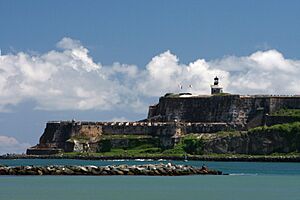
- 1508: Spain began to settle the area.
- 1539: Construction started on the first harbor defenses at El Morro.
- 1587: Engineers Juan de Tejada and Juan Bautista Antonelli created the main design for El Morro.
- 1595: Sir Francis Drake attacked El Morro by sea but failed.
- 1598: George Clifford attacked from land and took El Morro. But his forces left due to illness.
- 1625: The Dutch, led by Captain Balduino Enrico, attacked and burned parts of San Juan. El Morro held strong.
- 1630: Building of the city walls around San Juan began.
- 1765: Plans were made to make San Juan's defenses even stronger.
- 1797: British General Ralph Abercromby and Admiral Henry Harvey tried to invade but were defeated.
- 1825: The famous Puerto Rican pirate, Roberto Cofresí, was jailed and later executed inside the fort.
- 1843: The first lighthouse in Puerto Rico was built on top of the castle.
- 1898: On May 12, U.S. Navy ships bombed El Morro. Six months later, Puerto Rico became U.S. territory after the Spanish–American War.
- 1908: The current lighthouse on El Morro was built by the United States Navy.
- 1915: Lt. Teófilo Marxuach fired what are considered the first shots of World War I by the U.S. military.
- 1942: El Morro was still an active military post during World War II. The U.S. Army added concrete observation posts and an underground bunker.
- 1949: San Juan National Historic Site was created.
- 1961: The U.S. Army moved out, and the forts became part of the National Park Service.
- 1983: San Juan National Historic Site was declared a World Heritage Site by the United Nations.
- 1992: El Morro's grounds were returned to their historic 18th-century look. Modern roads and parking lots were removed. The Plaza del Quinto Centenario was built nearby.
- 2017: Hurricane Maria hit Puerto Rico. Tourism to El Morro recovered by 2019.
Images for kids
-
U.S. commemorative quarter, featuring a Sentry Box
See also
 In Spanish: Castillo San Felipe del Morro para niños
In Spanish: Castillo San Felipe del Morro para niños
- Puerto Rico Campaign
- Fuerte de San José
- List of the oldest buildings in Puerto Rico



